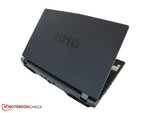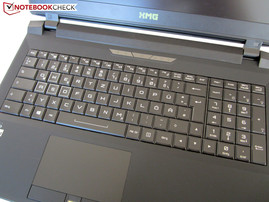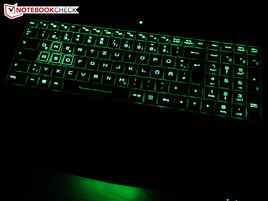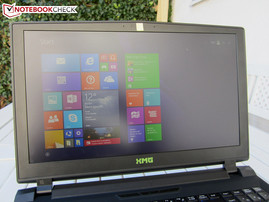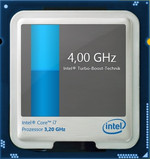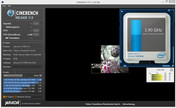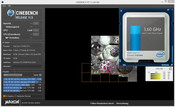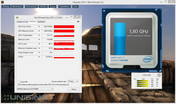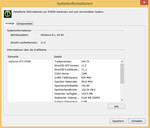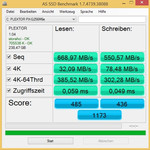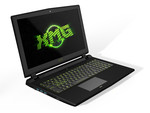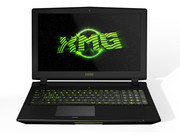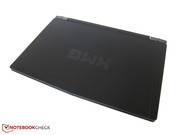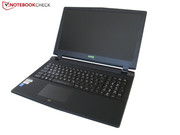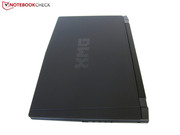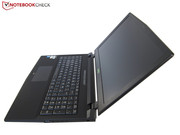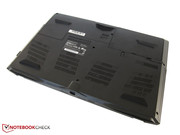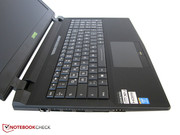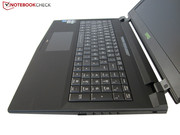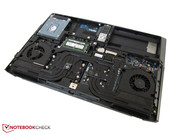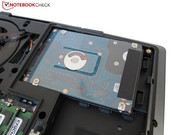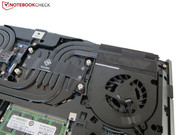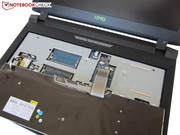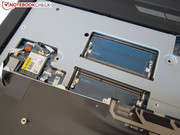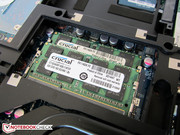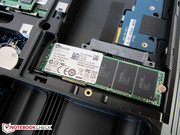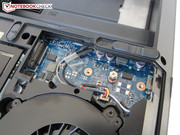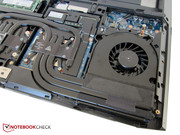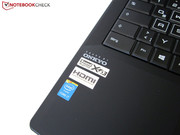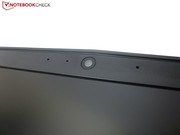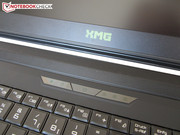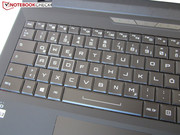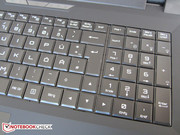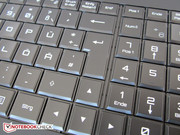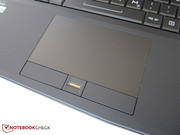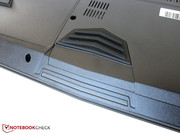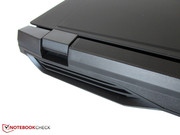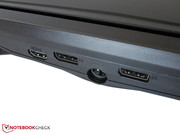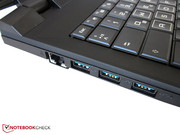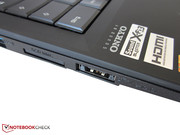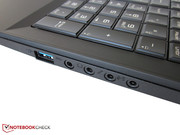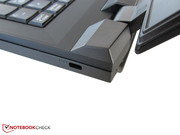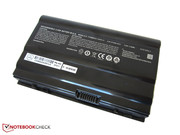Schenker XMG U505 (Clevo P751ZM) Notebook Review
For the original German review, see here.
Unlike the XMG P505, the XMG U505 does not use a mobile processor with a TDP of 47 Watts, but a desktop chip with a TDP of 35 to 65 Watts instead. Even CPUs with 84 to 88 Watts would be possible according to the barebones manufacturer Clevo. We selected a review unit with a Core i7-4790S and a maximum clock of 4.0 GHz to really stress the cooling solution. The other models either have a lower clock or a lower TDP and some CPUs do not support Hyperthreading , which means that you would be limited to four parallel threads.
Schenker Technologies offer individual configurations and you can customize other components, including the memory (4 to 32 GB DDR3 RAM), the display (1920x1080 to 3840x2160) or the graphics card. As well as the recently launched GeForce GTX 965M, Schenker also offers the faster siblings GTX 980M and GTX 970M. The latter currently offers the best price-performance ratio. There is also a large selection of hard drives: The chassis can accommodate up to four storage solutions. While the M.2 slots are designed for SSDs (SATA-III or PCIe), the 2.5-inch slots can also be equipped with conventional hard drives or hybrid solutions, respectively.
A disadvantage of many upgrade options is that there is no place for an optical drive, despite the thick chassis construction. It is laudable that you can choose between different keyboard versions. The wireless module is provided either by Intel (Wireless-AC 3160 or 7265, respectively) or Qualcomm Atheros (Killer 1525). An operating system is not included in the basic configuration, but Schenker will install Windows 7 or 8.1 for an additional charge of 89 to 169 Euros (~$103 to $196), respectively. The purchase price for a standard version of the XMG U505 without any hardware changes starts at 1,399 Euros (~$1620); our review configuration currently costs around 2,150 Euros (~$2490).
Case
We have already mentioned that the case is provided by the barebones experts from Clevo. With a height of 3.6 centimeters (~1.4 inches), the P751ZM chassis is much slimmer than the older 15-inch sibling P157SM (4.9 centimeters @ One K56-3N2, ~1.9 inches), but it is thicker compared to the brand-new P651 that is between 2.5 and 2.9 centimeters (~1.0 and 1.4 in) high depending on the graphics card. The latter is also noticeably lighter. Instead of 2.6 to 2.7 kilograms (~5.7 to 5.9 lb), the P751ZM weighs more than 3.4 kilograms (~7.5 lb), which means transporting the XMG U505 is quite inconvenient.
The greatest advantage of the P751ZM is its similarity to a typical desktop PC, and we do not necessarily mean the processor, but primarily the good maintainability and expandability. Both the CPU and GPU are plugged modules, so it is possible to replace them without changing the entire motherboard.
The design of the XMG U505 leaves a mixed impression. Yes, the shapes are looking more modern and zippier compared to other Clevo barebones, but the P751ZM is not really stylish or graceful. This is a result of the design in general, but also the materials used. Clevo primarily uses plastic that is rubberized in many places (lid and palm rest). Soft-touch surfaces are very nice to touch, but they tend to attract fingerprints when you have greasy fingers. Overall, we think the XMG P505 looks slightly better, especially since Clevo uses brushed aluminum for this model.
However, the greatest problem of the P751ZM is not the design, but the mediocre stability of the display cover. You can heavily twist it with two hands. It also produces creaking sounds and even the display frame can be loosened. Clevo should really improve this. Because of the shaky display cover, it is just enough for an average chassis rating (72% vs. 80% @ XMG P505). The two hinges could be firmer. Otherwise, the stability does not have to hide behind the rivals: The base unit is extremely pressure-resistant. Another small note before we get to the connectivity: The maximum opening angle is just adequate with 130 degrees.
Connectivity
Ports
The port variety is basically similar to the P651 Barebone, but the P751ZM still has a few additional ports and a better layout. On the right side is just one USB 3.0 port, a slot for a Kensington Lock and four audio ports (analog and digital surround sound), so it is easy to use an external mouse. External displays can be attached at the back where you can choose between one HDMI port and two DisplayPorts. Most ports are on the left side, including the card reader (MMC, RSMMC, SD, Mini SD, SDHC, SDXC) as well as four USB 3.0 ports. For comparison: The P651 Barebone had only three audio ports and four USB ports.
Communication
The Gigabit LAN port can be used for wired network connections; wireless access is provided by the Dual-Band 7265 adaptor. It supports all current standards like Bluetooth 4.0 and WLAN 802.11 a/b/g/n/ac (2.4 + 5.0 GHz). Intel specifies a maximum transfer rate of 867 Mbps. The signal quality was decent in our review, but not quite as good as the XMG P505. Windows indicated 2 bars at a distance of 10 to 15 meters (~33 to 49 ft) from the router and through several walls.
Security
Security is also an important aspect, and the P751ZM Barebone is equipped with a fingerprint reader (between the touchpad buttons) and a TPM 2.0 chip.
Maintenance
Hardly any gaming notebook can be opened as comfortably as the XMG U505. You have to loosen almost 20 screws before you could lift the bottom cover of the P651 Barebone with some force, but the maintenance covers of the P751ZM are only secured with 6 screws and it is very easy to remove them. The situation is just as convenient inside the case. As well as the fans, you can also access the cooling solution of the CPU and GPU. The same applies to the storage solutions and the primary memory slots.
It is rather tricky if you want to replace the wireless module or use the memory slots 3 and 4 because you will have to remove the keyboard first. Unfortunately, Clevo has marked only one of the two screws with "KB" (= keyboard). We like that the battery is not screwed inside the case (see XMG P505), but it is directly accessible from the outside – just like the old days.
Software
The XMG U505 runs very well ex-works, thanks to the lack of any bloat ware. We only want to mention the Control Center: The simple interface presents four operating modes (Silent, Energy-Saving, Performance and Entertainment) as well as several additional features, some of which can also be activated and deactivated via key combinations. The GPU driver of our review unit is the relatively new version 344.75.
Accessories
Potential buyers of the XMG U505 not only get a manual, but also a driver DVD, a cleaning cloth and some storage accessories (cover + screws). You will also get a genuine Windows DVD if you have ordered an operating system. The huge 230-Watt power adaptor at 17.5 x 8.5 x 3.5 centimeters (~6.9 x 3.4 x 1.4 in) is particularly striking. The external power supply weighs 890 grams (~2 lb) and the 8-cell battery 430 grams (~15.2 oz).
Warranty
The standard warranty period of 24 months can be extended to three (Premium @ 150 Euros; ~$174) or four years (Platinum @ 300 Euros; ~$347). Schenker promises a pick-up & return service as well as several months of immediate repair.
Input Devices
Keyboard
The keyboard is quite different from the <gs id="b02f65ce-b9f9-4ba2-8a2f-ed3db1c8a1d2" ginger_software_uiphraseguid="8d77d54a-9004-4d26-b5c4-ff157f77ad02" class="GINGER_SOFTWARE_mark">chiclet</gs> version of the P651 Barebone and on the whole we liked it slightly better. As well as the large and futuristic lettering, the illumination in particular is a positive aspect. Instead of one zone, the P751ZM has three zones, which can be configured in different colors via software. The P651 only had white illumination.
The typing experience on the XMG U505 is not bad. Despite the soft mechanics that remind us of Alienware notebooks, it still provides sufficient feedback. Unlike the P651, the keys are relatively quiet, which is an important aspect for many users. Clevo also deserves praise for the layout. Unlike the predecessor’s keyboard and many MSI notebooks, the (slightly narrow) Return key of the German layout is now higher (two rows). All keys are also at their usual spots <gs id="a0c3820f-364e-4612-af11-3a5653362e0e" ginger_software_uiphraseguid="eccd58c5-62a7-4f05-9047-406ca2312e37" class="GINGER_SOFTWARE_mark">(>< </gs>| and <gs id="8280ff46-6ad1-4a16-b8ca-cebc15c98f4d" ginger_software_uiphraseguid="eccd58c5-62a7-4f05-9047-406ca2312e37" class="GINGER_SOFTWARE_mark">Fn</gs> are not moved). A numeric keypad is obviously available. The top right corner allows you to adjust the intensity of the illumination or deactivate it completely.
Touchpad
The touchpad also leaves a good up to very good impression. It starts with the dimensions: 107 x 62 millimeters (~4.2 x 2.4 in) are decent for a 15-inch device and also allow greater movements on the screen. Another advantage is the smooth finish. Thanks to the missing structure, fingers are moving gently above the surface. You can easily locate the mouse replacement because it is slightly depressed and the material is different from the palm rest.
Clicks can be triggered with the dedicated buttons. Their quality is decent and they do not sound too noisy. Multi-touch is obviously supported, and the gestures work very well, except for the scrolling, which suffers from occasional dropouts. By the way, scrolling is also possible on the edge of the touchpad.
Display
You can choose between a Full HD, 3K or 4K display. Currently, very high-resolution panels still have some issues (scaling) and even high-end chips cannot handle the enormous pixel count, so we would still recommend a "standard" display with 1920x1080 pixels in 2015.
| |||||||||||||||||||||||||
Brightness Distribution: 78 %
Center on Battery: 250 cd/m²
Contrast: 1087:1 (Black: 0.23 cd/m²)
ΔE Color 3.41 | 0.5-29.43 Ø5
ΔE Greyscale 2.88 | 0.57-98 Ø5.3
90.3% sRGB (Argyll 1.6.3 3D)
59% AdobeRGB 1998 (Argyll 1.6.3 3D)
66.3% AdobeRGB 1998 (Argyll 2.2.0 3D)
90.7% sRGB (Argyll 2.2.0 3D)
66% Display P3 (Argyll 2.2.0 3D)
Gamma: 2.18
Our review unit is equipped with the AU Optronics B156HAN01.2 (AUO12ED) and the model is identical to the Full HD panel of the XMG P505, even though the values are not completely identical in all categories. We could only measure a brightness of 245 for the XMG U505 instead of 274, which is probably a result of production fluctuations. The black value on the other hand, is comparable with 0.23 cd/m². Dark movie and gaming passages look very crisp and there is no inconvenient gray hue. Unlike many other notebooks, the P751ZM does not suffer from a blue cast.
This is not a surprise since the Full HD panel is based on the IPS technology. It does not only ensure wide viewing angles, but usually also very accurate colors. The performance of the AU Optronics B156HAN01.2 is already pretty decent with the factory settings. It does not matter if you look at the grayscale, saturation or the color accuracy: Almost all the values are good. The color space coverage on the other hand is "just" decent, but 90% sRGB (Correction 20.5.2015 due to a wrong sRGB-reference-profile) and 59% AdobeRGB are not exceeded by many notebooks.
| SCHENKER XMG U505 | Acer Aspire V 15 Nitro VN7-591G-77A9 | MSI GS60 2QE Ghost Pro 4K (2QEUi716SR51G) | SCHENKER XMG P505 | Gigabyte P35X v3 | SCHENKER XMG P505 PRO | |
|---|---|---|---|---|---|---|
| Display | -4% | -21% | -1% | -7% | -2% | |
| Display P3 Coverage | 66 | 66.9 1% | 49.93 -24% | 64.1 -3% | 61.7 -7% | 63.8 -3% |
| sRGB Coverage | 90.7 | 84 -7% | 75.2 -17% | 92.3 2% | 85.1 -6% | 90.1 -1% |
| AdobeRGB 1998 Coverage | 66.3 | 61.4 -7% | 51.6 -22% | 64.9 -2% | 61.7 -7% | 65 -2% |
| Screen | -27% | -23% | 16% | -14% | -5% | |
| Brightness middle | 250 | 317 27% | 241 -4% | 345 38% | 374 50% | 286 14% |
| Brightness | 245 | 319 30% | 228 -7% | 333 36% | 350 43% | 274 12% |
| Brightness Distribution | 78 | 87 12% | 87 12% | 86 10% | 90 15% | 85 9% |
| Black Level * | 0.23 | 0.46 -100% | 0.45 -96% | 0.21 9% | 0.45 -96% | 0.24 -4% |
| Contrast | 1087 | 689 -37% | 536 -51% | 1643 51% | 831 -24% | 1192 10% |
| Colorchecker dE 2000 * | 3.41 | 5.79 -70% | 3.73 -9% | 3.02 11% | 4.25 -25% | 3.84 -13% |
| Greyscale dE 2000 * | 2.88 | 5.01 -74% | 3.23 -12% | 3.6 -25% | 4.9 -70% | 5.06 -76% |
| Gamma | 2.18 101% | 2.35 94% | 2.3 96% | 2.39 92% | 2.36 93% | 2.4 92% |
| CCT | 6445 101% | 7347 88% | 6610 98% | 7317 89% | 6294 103% | 6165 105% |
| Color Space (Percent of AdobeRGB 1998) | 59 | 55 -7% | 47 -20% | 59 0% | 56 -5% | 59 0% |
| Color Space (Percent of sRGB) | 90.3 | 91.1 1% | ||||
| Total Average (Program / Settings) | -16% /
-21% | -22% /
-23% | 8% /
12% | -11% /
-12% | -4% /
-4% |
* ... smaller is better
Performance
Processor
While the XMG P505 is limited to a Core i7-4720HQ with a nominal clock of 2.6 GHz (up to 3.6 GHz via Turbo Boost), you can equip the XMG U505 with <gs id="205cd89f-d1d6-4df9-89dc-048773a229ba" ginger_software_uiphraseguid="ee998919-103c-40f8-8b74-608c95e1bc1e" class="GINGER_SOFTWARE_mark">much more powerful CPUs</gs>. At least on paper, our benchmarks show that the advantage is actually not that great in practice. If you want to get the highest performance from the system, you will have to select a configuration with a 45 or 65-Watt model from the Core i7-series, respectively. They support Hyperthreading and can execute up to eight threads simultaneously.
Our review unit is powered by the Core i7-4790S with 3.2 to 4.0 GHz, which costs around 140 Euros (~$160) extra, and has 8 MB L3 cache (6 MB @ i7-4720HQ). That the XMG U505 is equipped with a desktop processor for the socket 1150 is apparent when you see the cooling solution. A total of five heat pipes take care of the heat from the high-end chip.
Clevo has omitted the switchable graphics feature for the HD Graphics 4600, so the user can use as many external displays as possible. Not only the power consumption suffers from the lack of Nvidia's Optimus technology, but also the battery runtime, which we will analyze later.
Turbo Boost
The Core i7-4970S can usually fully utilize its Turbo Boost potential. 3.9 to 4.0 GHz under single-core load and 3.6 GHz under multi-core load correspond with the maximum Turbo levels and are very respectable for a notebook. You have to stress the XMG U505 up to its limit before the Turbo gives up, but in practice this does not happen very often (even with demanding tasks). The processor settled at its nominal frequency during our stress tests with the tools FurMark and Prime95. Some cores also dropped below 3.2 GHz for a very short time.
CPU Performance
According to Cinebench R15, the XMG U505 is actually not that much faster than notebooks with a mobile CPU. Both the Single-Core as well as the Multi-Core rendering tests show that the 4790S is just 10% faster than the Core i7-4710HQ that runs with 2.5 to 3.5 GHz. More powerful notebook chips like the Core i7-4870HQ can even compete with the 4790S. However, the performance depends on many aspects and there might be a greater difference in CPU benchmarks that can benefit from the larger cache.
Graphics
A few weeks ago, Nvidia launched a very powerful gaming chip with the GeForce GTX 970M which is roughly as fast as the old top model GeForce GTX 880M (Kepler architecture). Considering the 1,280 unified shaders, the Maxwell chip is positioned between the GTX 965M and the GTX 980M that have 1,024 and 1,536 shaders, respectively.
The same applies to the memory; the GTX 965M (2 to 4 GB @ 128-bit) cannot keep up with 3 to 6 GB GDDR5 video memory and a 192-bit interface. Despite 4 to 8 GB VRAM and 256-bit, the new top version GeForce GTX 980M is only an option for very wealthy gamers. Our benchmarks show that the additional price is not justified for the additional performance (+20 to 30% for 350 Euros; ~$405 extra). The GeForce GTX 965M is also too expensive for the performance.
GPU Performance
We had already expected it: The processor does not really make a difference in the graphics benchmarks. Let us look at the Fire Strike test of 3DMark 13, for example. With a total score of 6,644 points, the XMG U505 is just slightly faster than other GTX 970M notebooks like the MSI GS60 (6,548 points). For comparison: A GTX 965M is almost 30% slower (4,810 points @ Schenker XMG P705), while a GeForce GTX 980M is around 25% faster (8,230 points @ Gigabyte P35X v3). It is a similar situation in the Unigine Heaven 3.0 benchmark: The GTX 970M manages 94 fps with 1920x1080 pixels. That is an advantage of around 40% more than the GTX 965M (66.3 fps), but almost 20% slower than the GTX 980M.
| 3DMark 11 Performance | 9629 points | |
| 3DMark Ice Storm Standard Score | 143659 points | |
| 3DMark Cloud Gate Standard Score | 21758 points | |
| 3DMark Fire Strike Score | 6644 points | |
Help | ||
| Unigine Heaven 3.0 - 1920x1080 DX 11, Normal Tessellation, High Shaders AA:Off AF:Off (sort by value) | |
| SCHENKER XMG U505 | |
| SCHENKER XMG P505 | |
| Gigabyte P35X v3 | |
| SCHENKER XMG P505 PRO | |
Storage Devices
Clevo equips the P751ZM Barebone with two M.2 slots to make it as future-proof as possible, one of which supports PCI-Express. We have already reviewed the XMG P505 with the x4 product Samsung XP941, and the XMG U505 uses the x2 rival Plextor M6e.
AS SSD shows that the performance of the 256 GB version is closer to a conventional SATA-III SSD than the Samsung XP941, even though the latter is supposed to get very hot. With a sequential read performance of 668 MB/s and a sequential write performance of 550 MB/s, the Plextor M6e is around 20 to 30% faster than the 256 GB Micron M600, which uses a SATA-III interface (522 and 469 MB/s, respectively). The Samsung XP941 even manages 1,000 MB/s in the read test, but the Plextor M6e is faster with small files (4K). The SSD type does not really have any effect in practice; the PCIe interface does not provide an advantage in most scenarios.
If you require a lot of storage, you should complement the Solid State Drive with an HDD. One of our favorites is the HGST Travelstar 7K1000. Thanks to the generous capacity and high speed, it is often faster than 5,400 drives. Many HDDs can only dream of almost 140 MB/s in the sequential read and write test of CrystalDiskMark.
System Performance
The combination of a desktop CPU, high-end GPU and Solid State Drive results in a great system performance. 6,411 points in PCMark 7 are hardly reached by any notebook.
| PCMark 7 Score | 6411 points | |
| PCMark 8 Home Score Accelerated v2 | 4970 points | |
| PCMark 8 Creative Score Accelerated v2 | 5394 points | |
| PCMark 8 Work Score Accelerated v2 | 5172 points | |
Help | ||
Gaming Performance
In short: The desktop processor does not really affect the performance in the gaming benchmarks. The average result of the XMG U505 is rather similar to the review configuration of the XMG P505 (Core i7-4870HQ).
The benchmark table clearly shows that the GeForce GTX 970M is a powerful gaming GPU. Even GPU-demanding blockbuster games like Call of Duty: Advanced Warfare, Ryse: Son of Rome or Battlefield 4 run with more than 40 or even 50 fps in the ultra setting. Only Assassin’s Creed: Unity did not run smoothly with the highest details and 1920x1080 pixels. However, this is not really surprising because the game is poorly optimized. But Assassin's Creed or not: The GTX 970M should easily be sufficient for the next 1 to 3 years if you do not always have to use the highest anti-aliasing settings.
| The Crew - 1920x1080 Ultra Video Preset (modified) AA:4x MS (sort by value) | |
| SCHENKER XMG U505 | |
| Assassin's Creed Unity - 1920x1080 Ultra High Graphics Quality AA:4x MS (sort by value) | |
| SCHENKER XMG U505 | |
| SCHENKER XMG P505 PRO | |
| Call of Duty: Advanced Warfare - 1920x1080 Extra / On (Cache Shadow Maps Off), 2x Supersampling AA:2x SM (sort by value) | |
| SCHENKER XMG U505 | |
| Gigabyte P35X v3 | |
| SCHENKER XMG P505 PRO | |
| Civilization: Beyond Earth - 1920x1080 Ultra Preset AA:4x MS (sort by value) | |
| SCHENKER XMG U505 | |
| Gigabyte P35X v3 | |
| F1 2014 - 1920x1080 Ultra Preset AA:4x MS (sort by value) | |
| SCHENKER XMG U505 | |
| The Evil Within - 1920x1080 High / Enabled AA:SM (sort by value) | |
| SCHENKER XMG U505 | |
| SCHENKER XMG P505 PRO | |
| Ryse: Son of Rome - 1920x1080 Very High Texture Res. + High Graphics Quality (Motion Blur & Temporal AA On, Rest Off/Disabled) AF:8x (sort by value) | |
| SCHENKER XMG U505 | |
| SCHENKER XMG P505 | |
| Fifa 15 - 1920x1080 High Preset AA:4x MS (sort by value) | |
| SCHENKER XMG U505 | |
| SCHENKER XMG P505 | |
| Gigabyte P35X v3 | |
| Battlefield 4 - 1920x1080 Ultra Preset AA:4x MS (sort by value) | |
| SCHENKER XMG U505 | |
| SCHENKER XMG P505 | |
| Gigabyte P35X v3 | |
| Saints Row IV - 1920x1080 Ultra Preset AA:8x MS AF:16x (sort by value) | |
| SCHENKER XMG U505 | |
| SCHENKER XMG P505 | |
| Dota 2 - 1920x1080 High / On, Render Quality: 100 % (sort by value) | |
| SCHENKER XMG U505 | |
| Gigabyte P35X v3 | |
| BioShock Infinite - 1920x1080 Ultra Preset, DX11 (DDOF) (sort by value) | |
| SCHENKER XMG U505 | |
| Acer Aspire V 15 Nitro VN7-591G-77A9 | |
| SCHENKER XMG P505 | |
| Crysis 3 - 1920x1080 Very High Preset AA:2xSM AF:16x (sort by value) | |
| SCHENKER XMG U505 | |
| SCHENKER XMG P505 | |
| Gigabyte P35X v3 | |
| Hitman: Absolution - 1920x1080 Ultra Preset AA:4xMS AF:16x (sort by value) | |
| SCHENKER XMG U505 | |
| SCHENKER XMG P505 | |
| SCHENKER XMG P505 PRO | |
| low | med. | high | ultra | |
| Hitman: Absolution (2012) | 99.5 | 93.8 | 81.3 | 40.7 |
| Crysis 3 (2013) | 139.7 | 114.3 | 83.2 | 33.4 |
| BioShock Infinite (2013) | 251.4 | 195 | 180.3 | 74 |
| Dota 2 (2013) | 119.7 | 116.6 | 111.4 | |
| Saints Row IV (2013) | 96 | 85.6 | 78.3 | 57.8 |
| Battlefield 4 (2013) | 198.8 | 178.1 | 135.2 | 55.2 |
| Fifa 15 (2014) | 282.6 | 249 | 200.9 | |
| Ryse: Son of Rome (2014) | 86.4 | 74.2 | 51 | 46.8 |
| The Evil Within (2014) | 107.9 | 106.7 | 71.1 | |
| F1 2014 (2014) | 118 | 118 | 117 | 102 |
| Civilization: Beyond Earth (2014) | 158 | 120.4 | 83.4 | 72 |
| Call of Duty: Advanced Warfare (2014) | 153.3 | 107.1 | 77.3 | 48.4 |
| Assassin's Creed Unity (2014) | 71.2 | 57 | 39 | 22.6 |
| The Crew (2014) | 60 | 60 | 60 | 52.3 |
Emissions
System Noise
While Clevo Barebones were amongst the louder gaming notebooks in the past, the current generation does not sound like a jet engine anymore. Almost 42 dB(A) in 3DMark 06 and up to 45 dB(A) under maximum load are clearly audible, but the noise is never really annoying. Slimmer 15-inch rivals like the MSI GS60 or the Gigabyte P35X v3 reach more than 50 dB(A), which is subjectively a huge difference. The Schenker XMG P505 is also louder than the XMG U505 in the stress test.
The fans are quite restrained while idling. 32 dB(A) is a good average result. The dreaded and often useless pulsating is also very limited in the case of the P751ZM Barebone. You will only hear more than 35 dB(A) when you stress the notebook.
| SCHENKER XMG U505 | Acer Aspire V 15 Nitro VN7-591G-77A9 | MSI GS60 2QE Ghost Pro 4K (2QEUi716SR51G) | SCHENKER XMG P505 | Gigabyte P35X v3 | SCHENKER XMG P505 PRO | |
|---|---|---|---|---|---|---|
| Noise | 3% | -7% | -7% | -8% | -3% | |
| Idle Minimum * | 32 | 29.6 7% | 32.6 -2% | 30.2 6% | 29.4 8% | 30.4 5% |
| Idle Average * | 32.3 | 30.6 5% | 34.8 -8% | 34.4 -7% | 30.9 4% | 33.6 -4% |
| Idle Maximum * | 34.8 | 31.4 10% | 38 -9% | 38.2 -10% | 36 -3% | 36.6 -5% |
| Load Average * | 42 | 44.4 -6% | 43.4 -3% | 46.6 -11% | 54.3 -29% | 43.4 -3% |
| Load Maximum * | 45.2 | 44.6 1% | 52 -15% | 50.6 -12% | 54.6 -21% | 47.8 -6% |
* ... smaller is better
Noise Level
| Idle |
| 32 / 32.3 / 34.8 dB(A) |
| HDD |
| 32.3 dB(A) |
| Load |
| 42 / 45.2 dB(A) |
 | ||
30 dB silent 40 dB(A) audible 50 dB(A) loud |
||
min: | ||
Temperature
The XMG U505 is already quite warm while idling, probably because of the desktop processor. Around 36 °C (~96.8 °F) at the top and the bottom are slightly disappointing, especially since the left side of the palm rest reaches almost 40 °C (~104 °F). We suspect that this is caused by the 7,200 rpm hard drive. The right area, which is designed for the battery, stays noticeably cooler. We can hardly criticize the temperature development under load. Up to 47 °C (~116.6 °F; top) and 53 °C (~127.4 °F; bottom) are typical for a high-end notebook. Some rivals reached more than 60 °C (~140 °F) in the stress test (Gigabyte P35X v3, MSI GS60 …).
We can see that only the Core i7-4790S is a hot head among the hardware. Despite the deactivated Turbo feature, the 65-Watt model reached almost 90 °C (~194 °F) under maximum load. The GeForce GTX 970M, which throttled slightly in FurMark, leveled off at around 70 °C (~158 °F).
| SCHENKER XMG U505 | Acer Aspire V 15 Nitro VN7-591G-77A9 | MSI GS60 2QE Ghost Pro 4K (2QEUi716SR51G) | SCHENKER XMG P505 | Gigabyte P35X v3 | SCHENKER XMG P505 PRO | |
|---|---|---|---|---|---|---|
| Heat | 11% | 1% | -7% | -12% | 3% | |
| Maximum Upper Side * | 46.7 | 48 -3% | 48 -3% | 50.7 -9% | 51 -9% | 54.2 -16% |
| Maximum Bottom * | 53.2 | 47.6 11% | 65.1 -22% | 75.8 -42% | 60.3 -13% | 59.4 -12% |
| Idle Upper Side * | 39.1 | 32.3 17% | 29.9 24% | 36.5 7% | 41.4 -6% | 30.8 21% |
| Idle Bottom * | 38.5 | 30.8 20% | 36.1 6% | 32.7 15% | 45.3 -18% | 31.1 19% |
* ... smaller is better
(-) The maximum temperature on the upper side is 46.7 °C / 116 F, compared to the average of 40.4 °C / 105 F, ranging from 21.2 to 68.8 °C for the class Gaming.
(-) The bottom heats up to a maximum of 53.2 °C / 128 F, compared to the average of 43.2 °C / 110 F
(±) In idle usage, the average temperature for the upper side is 36.4 °C / 98 F, compared to the device average of 33.8 °C / 93 F.
(±) The palmrests and touchpad can get very hot to the touch with a maximum of 38.8 °C / 101.8 F.
(-) The average temperature of the palmrest area of similar devices was 28.9 °C / 84 F (-9.9 °C / -17.8 F).
Speakers
The sound is surprisingly rich and balanced, even though the P751ZM Barebone does not have a subwoofer. Bass is decently powerful, which is quite rare in the notebook segment. It seems that Clevo did a very good job with the sound system in general. The two Onkyo speakers (above the keyboard) are supported by a software from Creative. Sound Blaster X-Fi MB3 creates a richer and spatial sound.
Audio contents can appear rather distorted with higher volume settings, but the maximum volume still deserves respect. You can still hear all the details, even when you are a few meters away from the notebook. The speakers of the XMG P505 do not sound as good because of the limited space.
Energy Management
Power Consumption
One of the greatest weaknesses of the XMG U505 is the enormous idle consumption, which is caused on the one hand by the missing Optimus technology, and on the other, the desktop processor. 33 to 48 Watts indicate that the notebook does not manage good battery runtimes. High-end laptops with switchable graphics only consume between 10 to 30 Watts depending on the configuration.
The values are closer to each other under load. 112 Watts on average in the first scene of 3DMark 06 and up to 203 Watts under maximum load remind us of the XMG P505 (Core i7-4870HQ, GeForce GTX 970M), but it was equipped with a 4K panel that consumed a lot of power. Annoying: The consumption during standby and when the device is turned off is increased from 0.5 and 0.1 Watts to 6 and 7 Watts with the battery, which is too high. And yes, we talk about a fully charged battery.
| SCHENKER XMG U505 | Acer Aspire V 15 Nitro VN7-591G-77A9 | MSI GS60 2QE Ghost Pro 4K (2QEUi716SR51G) | SCHENKER XMG P505 | Gigabyte P35X v3 | SCHENKER XMG P505 PRO | |
|---|---|---|---|---|---|---|
| Power Consumption | 53% | 35% | 22% | 31% | 37% | |
| Idle Minimum * | 32.8 | 6.2 81% | 15.3 53% | 19.9 39% | 16.4 50% | 12 63% |
| Idle Average * | 38.5 | 10.2 74% | 20 48% | 24 38% | 21.4 44% | 17.8 54% |
| Idle Maximum * | 48.3 | 21.4 56% | 26.2 46% | 32.6 33% | 25.9 46% | 22.2 54% |
| Load Average * | 111.9 | 85.5 24% | 102.6 8% | 110.6 1% | 107.8 4% | 94.2 16% |
| Load Maximum * | 202.7 | 136.9 32% | 162.7 20% | 203 -0% | 181 11% | 207.5 -2% |
* ... smaller is better
| Off / Standby | |
| Idle | |
| Load |
|
Battery Runtime
The runtimes of the XMG U505 are hardly worth mentioning. 1.5 up to 2.5 hours: Unfortunately, you do not get better results without switchable graphics. The Gigabyte P35X v3 manages up to six hours, despite the more powerful GPU and the MSI GS60, which has a 40% smaller battery (52 vs. 82 Wh), can only laugh about the idle consumption of the P751ZM Barebone.
| SCHENKER XMG U505 | Acer Aspire V 15 Nitro VN7-591G-77A9 | MSI GS60 2QE Ghost Pro 4K (2QEUi716SR51G) | SCHENKER XMG P505 | Gigabyte P35X v3 | SCHENKER XMG P505 PRO | |
|---|---|---|---|---|---|---|
| Battery Runtime | 137% | 12% | -2% | 75% | 54% | |
| Reader / Idle | 150 | 596 297% | 276 84% | 174 16% | 364 143% | 298 99% |
| Load | 89 | 68 -24% | 36 -60% | 71 -20% | 94 6% | 96 8% |
Verdict
It primarily depends on the usage scenario whether you prefer the XMG P505 or the XMG U505. The XMG P505 is the better choice if you travel frequently and like a slimmer notebook. If you prefer a desktop replacement that is as fast as possible, has good maintainability and upgradeability, you should definitely get the XMG U505.
Directly accessible battery, no soldered components (CPU + GPU), a lot of ports: The P751ZM Barebone is designed for "real" gamers that want to have full control over their system. The chassis leaves a good impression if you ignore the wobbly lid, the soft-touch finish that attracts dirt and the heavy weight. The barebone experts from Clevo also did a good job with the input devices, the display and the speakers.
The power consumption and the battery runtime are not the most important aspects for a real gaming notebook, so in the end, it is still enough for a "very good" rating. Only the Asus G751JY and the MSI GT72 2QE have received this award in the last six months.


 Deutsch
Deutsch English
English Español
Español Français
Français Italiano
Italiano Nederlands
Nederlands Polski
Polski Português
Português Русский
Русский Türkçe
Türkçe Svenska
Svenska Chinese
Chinese Magyar
Magyar
